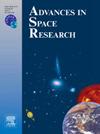来自ICON数据的赤道等离子体气泡的全球模式
IF 2.8
3区 地球科学
Q2 ASTRONOMY & ASTROPHYSICS
引用次数: 0
摘要
赤道等离子体气泡(EPBs)是一种电离层损耗,可以破坏卫星通信和导航系统。本研究使用来自NASA电离层连接探测器(ICON)任务的完整离子密度数据集,研究了epb的纵向、季节性和地磁变化。采用双参数检测方法,结合σ指数(σ大于或等于0.5)和相对离子密度耗尽条件(ΔNi<0),用于识别2020年至2022年的epb。分析的重点是在±10°磁纬范围内的午夜前(18:00-23:00 SLT)观测数据,以及午夜后(00:00-05:00 SLT)的数据,以比较受干扰条件下的反应。午夜前的强磁暴在南美洲和大西洋地区尤为频繁,这两个地区的发生率最高。然而,在其他地区,特别是印度、东南亚和东亚地区,在春分期间也观察到高EPB活动,这与已建立的气候学和太阳终端与地磁场对准的作用相一致。EPB发生率在2022年最高,在2020年最低,反映了太阳活动在第25太阳周期上升阶段增加。从季节上看,在春分期间发生的频率最高,尽管在南美洲观测到12月至日的最大值。在地磁干扰条件下,午夜前EPB率略有下降,特别是在南美洲,尽管在全球范围内并不明显。相比之下,午夜后的epb在受干扰期间显示出统计学上显著的增加。这些发现表明,在太阳周期25上升阶段的早期,EPB对地磁变率的响应具有明显的区域和局部时间依赖性。本文章由计算机程序翻译,如有差异,请以英文原文为准。
Global patterns of equatorial plasma bubbles from ICON data
Equatorial plasma bubbles (EPBs) are ionospheric depletions that can disrupt satellite communication and navigation systems. This study examines the longitudinal, seasonal, and geomagnetic variability of EPBs using the full ion density dataset from NASA’s Ionospheric Connection Explorer (ICON) mission. A dual-parameter detection method, combining the index () and a relative ion density depletion condition (), was applied to identify EPBs from 2020 to 2022. The analysis focused on pre-midnight (18:00–23:00 SLT) observations within magnetic latitude, with post-midnight (00:00–05:00 SLT) data included to compare responses under disturbed conditions. Pre-midnight EPBs were especially frequent over South America and the Atlantic sector, where occurrence rates peaked. However, high EPB activity was also observed in other regions, particularly the Indian, Southeast Asian, and East Asian sectors, during equinoxes, consistent with established climatology and the role of solar terminator alignment with the geomagnetic field. EPB occurrence rates were highest in 2022 and lowest in 2020, reflecting increasing solar activity during the ascending phase of Solar Cycle 25. Seasonally, occurrence was highest during the equinoxes, although a December solstice maximum was observed over South America. Under geomagnetically disturbed conditions, pre-midnight EPB rates declined modestly, particularly over South America, though not significantly at the global scale. In contrast, post-midnight EPBs showed a statistically significant increase during disturbed periods. These findings illustrate clear regional and local time dependencies in EPB responses to geomagnetic variability during the early years of the ascending phase of Solar Cycle 25.
求助全文
通过发布文献求助,成功后即可免费获取论文全文。
去求助
来源期刊

Advances in Space Research
地学天文-地球科学综合
CiteScore
5.20
自引率
11.50%
发文量
800
审稿时长
5.8 months
期刊介绍:
The COSPAR publication Advances in Space Research (ASR) is an open journal covering all areas of space research including: space studies of the Earth''s surface, meteorology, climate, the Earth-Moon system, planets and small bodies of the solar system, upper atmospheres, ionospheres and magnetospheres of the Earth and planets including reference atmospheres, space plasmas in the solar system, astrophysics from space, materials sciences in space, fundamental physics in space, space debris, space weather, Earth observations of space phenomena, etc.
NB: Please note that manuscripts related to life sciences as related to space are no more accepted for submission to Advances in Space Research. Such manuscripts should now be submitted to the new COSPAR Journal Life Sciences in Space Research (LSSR).
All submissions are reviewed by two scientists in the field. COSPAR is an interdisciplinary scientific organization concerned with the progress of space research on an international scale. Operating under the rules of ICSU, COSPAR ignores political considerations and considers all questions solely from the scientific viewpoint.
 求助内容:
求助内容: 应助结果提醒方式:
应助结果提醒方式:


